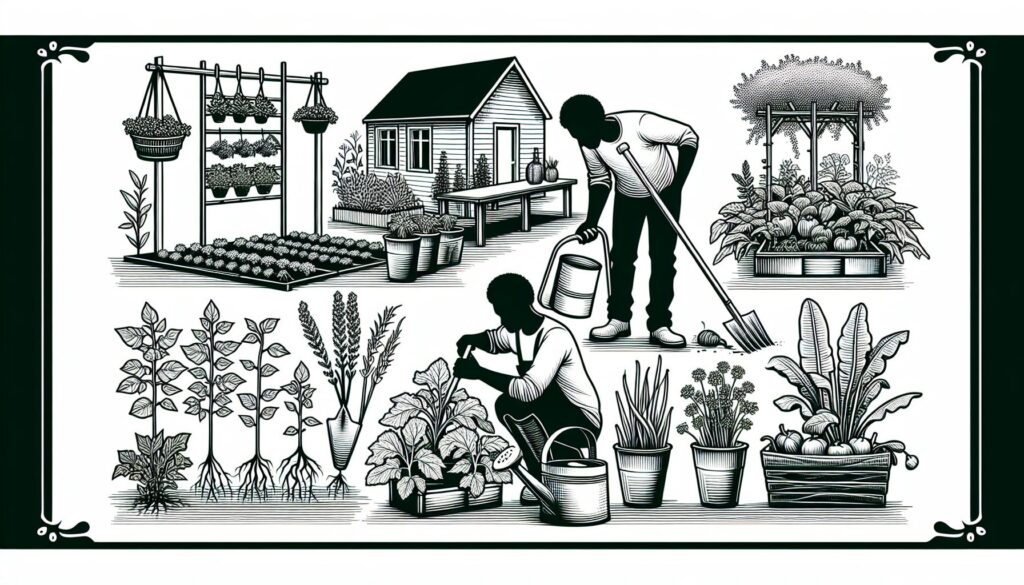Thinking of starting your own home vegetable garden? I’m here to guide you through the process step by step. From choosing the right location to selecting the best vegetables to grow, I’ve got you covered.
Growing your own vegetables at home is not only rewarding but also a great way to ensure a fresh and healthy supply of produce. In this ultimate guide, I’ll share expert tips and tricks to help you create a thriving garden right in your backyard.
Choosing the Right Location
When selecting a location for your home vegetable garden, I always recommend opting for a spot that receives at least 6-8 hours of sunlight daily. This ensures that your plants get the energy they need to thrive and produce a bountiful harvest.
In addition to sunlight, it’s important to consider accessibility to water sources. Position your garden near a water hose or irrigation system to make watering convenient and efficient. Remember, consistency in watering is key to healthy plant growth.
Good drainage is another crucial factor to keep in mind. Avoid low-lying areas where water tends to accumulate, as this can lead to root rot and other issues. Opt for a slightly elevated spot or consider raised beds to improve drainage.
Lastly, think about proximity to your home. Choosing a location that is easily accessible from your house makes it more likely that you’ll spend time in the garden, tending to your plants and enjoying the fruits of your labor.
By considering these key factors when selecting the right location for your home vegetable garden, you’re setting yourself up for success in growing a thriving and productive garden right in your own backyard.
Selecting the Best Vegetables to Grow
When starting a home vegetable garden, it’s crucial to choose vegetables that thrive in your climate and suit your taste preferences. Here are some key factors to consider when selecting what to grow:
- Climate suitability: Opt for vegetables that are well-suited to your local climate for better chances of success. Consider factors like temperature, sunlight hours, and frost dates.
- Space availability: If you have limited space, focus on compact plants or those that can be grown vertically to maximize your garden area.
- Time commitment: Pick vegetables that align with the time you can dedicate to garden maintenance. Some varieties require more care than others.
- Dietary preferences: Choose vegetables that you and your family enjoy eating. It’s rewarding to harvest produce that you’re excited to incorporate into your meals.
- Success rate: For beginner gardeners, start with easy-to-grow vegetables like tomatoes, lettuce, radishes, and carrots to build confidence and experience.
By considering these factors when selecting the best vegetables for your home garden, you can set yourself up for a bountiful harvest that brings joy and satisfaction.
Preparing the Soil
When starting a home vegetable garden, Preparing the Soil is a crucial step for ensuring successful plant growth. Here are some tips I always follow:
- Start by testing the soil pH levels to determine its acidity or alkalinity, ensuring it’s suitable for the vegetables I plan to grow.
- Improving soil structure by adding organic matter like compost or aged manure helps enhance nutrient retention and drainage.
- I always make sure to till the soil to break up compacted areas and create a loose, aerated environment for root growth.
- Spacing my plants adequately is important to prevent overcrowding, allowing each plant to access nutrients and sunlight effectively.
- Mulching the soil helps retain moisture, suppress weed growth, and maintain a consistent soil temperature for optimal plant development.
Remember, a healthy and nutrient-rich soil is the foundation for a thriving vegetable garden.
Planting and Watering Techniques
When it comes to planting your home vegetable garden, proper spacing between plants is crucial. Overcrowding can lead to competition for nutrients and water. I always refer to the recommended spacing guide for each type of vegetable I plant to ensure optimal growth.
Deep watering is key to encourage strong root development. Rather than watering lightly every day, I prefer to water deeply a few times a week. This helps the roots grow deeper into the soil, making the plants more resilient to drought conditions.
Mulching is a fantastic way to retain moisture in the soil and suppress weed growth. I always apply a layer of organic mulch around my plants to help the soil retain moisture and reduce the need for frequent watering.
Utilizing a soaker hose or drip irrigation system can make watering more efficient by delivering water directly to the base of the plants. This method also helps prevent evaporation and ensures that water is used where it’s needed most.
Remember, consistent watering is essential to ensure your vegetable garden thrives. By following these planting and watering techniques, you can set your plants up for success in their growth journey.
Maintaining Your Home Vegetable Garden
After establishing your home vegetable garden, it’s essential to maintain it properly to ensure healthy plant growth and abundant harvests. Here are some key practices to keep your garden thriving:
- Weeding: Regularly remove weeds to prevent them from competing for nutrients and water with your vegetable plants.
- Monitoring: Keep an eye on your plants for any signs of pests or diseases. Early detection can help you address issues promptly.
- Fertilizing: Provide your plants with the nutrients they need by fertilizing them appropriately. Choose a fertilizer suitable for vegetables.
- Pruning: Trim dead or damaged leaves and branches to promote healthy growth and increase air circulation around the plants.
- Supporting: Plants like tomatoes, cucumbers, and peas may require support as they grow. Use stakes or trellises to keep them upright.
- Harvesting: Regularly harvest ripe vegetables to encourage further production. Don’t let them overripe on the plant.
- Crop Rotation: Rotate your crops each season to reduce the risk of pests and diseases that target specific plant families.
- Inspecting: Check your garden regularly for any irregularities in plant growth, soil moisture, or signs of stress.
Remember, consistency is key in maintaining a successful home vegetable garden. By staying attentive to your plants’ needs and addressing challenges promptly, you’ll set yourself up for a bountiful and rewarding gardening experience.
Key Takeaways
- Choose a location for your home vegetable garden that gets 6-8 hours of daily sunlight, has good drainage, and is easily accessible for watering and maintenance.
- Select vegetables that are suitable for your climate, space availability, time commitment, dietary preferences, and success rate to ensure a bountiful harvest.
- Prepare the soil by testing pH levels, improving soil structure with organic matter, tilling for a loose environment, spacing plants adequately, and using mulch for moisture retention.
- Plant with proper spacing, deep watering practices, mulching for moisture retention, and consider using soaker hoses for efficient irrigation.
- Maintain your garden by weeding regularly, monitoring for pests and diseases, fertilizing appropriately, pruning for healthy growth, supporting plants as needed, harvesting ripe vegetables, rotating crops, and inspecting for irregularities.
Conclusion
Maintaining a successful home vegetable garden requires attention to key practices like weeding, pest monitoring, fertilization, pruning, support provision, harvesting, crop rotation, and regular inspection. By following these maintenance steps diligently, gardeners can enjoy healthy plant growth, bountiful harvests, and a fulfilling gardening journey. Remember, a well-tended vegetable garden not only yields fresh produce but also provides a therapeutic and rewarding experience for garden enthusiasts like myself. Happy gardening!



